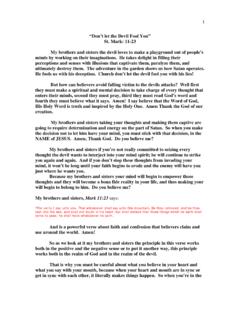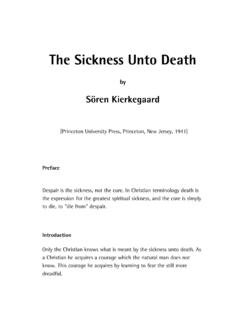Transcription of Langmuir, Freundlich, Temkin and Dubinin Radushkevich ...
1 IOSR Journal of Applied Chemistry (IOSR-JAC) ISSN: 2278-5736. Volume 3, Issue 1(Nov. Dec. 2012), PP 38-45 38 | Page langmuir , freundlich , Temkin and Dubinin Radushkevich Isotherms Studies of Equilibrium Sorption of Zn2+ Unto Phosphoric Acid Modified Rice Husk Dada, *, Olalekan, , Olatunya, , DADA, O4 *1 Department of Physical Sciences (Industrial Chemistry Unit), Landmark University, 1001, Omu-Aran, Kwara, State, Nigeria 2 Department of Chemical Engineering, Landmark University, 1001, Omu-Aran, Kwara State, Nigeria. 3 Department of Chemistry, Ekiti State University, 5363, Ado-Ekiti, Ekiti State, Nigeria. 4 Department of Chemistry, University of Ilorin, 1515, Ilorin, Kwara State, Nigeria. Abstract : Equlibrium sorption of the phosphoric acid modified rice husk was studied. The Physico-chemical properties of the modified rice husk were determined. The equilibrium sorption data were fitted into langmuir , freundlich , Temkin and Dubinin Radushkevich (DRK) isotherms.
2 Of the four adsorption isotherm, the R2 value of langmuir isotherm model was the highest. The maximum monolayer coverage (Qo) from langmuir isotherm model was determined to be , the separation factor indicating a favourable sorption experiment is Also from freundlich Isotherm model, the sorption intensity (n) which indicates favourable sorption and the correlation value are and 0,89 respectively. The heat of sorption process was estimated from Temkin Isotherm model to be and the mean free energy was estimated from DRK isotherm model to be which vividly proved that the adsorption experiment followed a physical process. Keywords: Heavy metals, Isotherms, Rice husk and Sorption. I. INTRODUCTION Heavy metals are widely distributed in the environment and are ecologically important due to their high toxicity for living organisms including human beings [1]. Several industrial activities are important sources of environmental pollution due to their high content of several heavy metal ions.
3 In particular, Zn2+ is a common metal ions found in effluents of a large number of industries. This metal is an essential element for life and is a micronutrient in trace amounts [2]. However, a chronic exposure to Zn2+ is detrimental for human health. The toxicological profile of this pollutant has been well documented in literature and its presence in water and wastewaters is a potential risk for the environment and public health [2,3]. Therefore, it is necessary to design feasible processes to minimize the pollution caused by Zn2+ discharges and to reduce the risks associated to its presence in the environment. A wide range of various treatment techniques such as ion exchange, biodegradation, oxidation, solvent extraction and adsorption have been reported to be used for removal of heavy metal ions from industrial effluents [4]. However, adsorption has been universally accepted as one of the most effective pollutant removal process, with low cost, ease in handling, low consumption of reagents, as well as scope for recovery of value added components through desorption and regeneration of adsorbent [5,6] A notable and growing trend is to evaluate the feasibility and suitability of natural, viable, renewable and low-cost materials which will be used as adsorbent to combat the menace of heavy metal pollution.
4 The afore-mentioned growing trend is the main objective of this research via the modification of rice husk and evaluation of the equilibrium sorption data using the notable adsorption isotherms such as langmuir , freundlich , Temkin and Dubibin-Raduskevich isotherms. Rice husk is an agricultural waste material, a hard protecting coverings of grains of rice obtained from the threshing of the rice and constitutes about 20% of 650 million tons of rice produced annually in the world [7]. Rice husk has found several applications in household, industries and even in the treatment of direct dyes [8]. II. EXPERIMENTAL METHODS Collection and Preparation of Adsorbent and Adsorbate All chemicals used were of analytical grade. Rice husk was obtained from a local mill in Ilorin, Kwara State and was pre-treated according to the method reported in the literature [9,10]. The rice husk was screened and washed with de-ionized water to remove dirt and metallic impurities after which it was dried in the oven at about 105oC for 2 hours.
5 The dried rice husk was grounded and sieved in the mesh in the range between 250 m and 150 m in order to increase its surface area. The modification was langmuir , freundlich , Temkin And Dubinin Radushkevich Isotherms Studies Of Equilibrium 39 | Page done by chemical treatment of 50g of the sieved rice husk with orthophosphoric acid (H3PO4) heated on the magnetic stirrer at 1000C until it totally formed a paste. The modified rice husk was washed with de-ionized water until the pH 6. It was later dried in the oven at about 800C to remove moisture. The name given to the adsorbent is rice husk modified with phosphoric acid, RH MP. The Preparation of Adsorbate was carried out by preparing stock solution containing 1000 mg/L of Zn. of Zn(NO3)2 in 1000cm3 of de-ionized water. Working concentrations in the range of 10mg/L 200 mg/L were prepared by serial dilution. The RH MP was characterized by determining the following parameters: specific surface area, moisture content, loss of mass on ignition, pH and bulk density using standard procedures: Specific surface area Saers method was used for the determination of the surface area [11, 12].
6 A sample containing of the RH MP was acidified with HCl to pH 3 , the volume was made up to 50cm3 with de-ionized water after addition of of NaCl. The titration were carried out with standard NaOH in a thermostatic bath at 298 to pH , and then to pH The volume V required to raise the pH from to was noted and the surface area was computed from the following equation: 2532)/(2 (1) Determination the moisture content. This was done by weighing 5g of RH MP into a crucible. This was placed in the oven and heated for 5hours at constant temperature of 105 C. The sample was then removed and put rapidly into a desiccator in order to prevent more moisture uptake from atmosphere. The sample was re-weighed. This procedure was repeated several times until a constant weight was obtained. The difference in the mass constitutes the amount of moisture content of the adsorbent [13] 100%1232 (2) W1 = Weight of crucible W2 = Initial weight of crucible with sample W3 = Final weight of crucible with sample The determination of loss of mass The determination of loss of mass on ignition was done by weighing 10g of the adsorbent (RH MP) and put inside furnace at constant temperature of 600 C for 2hours.
7 After roasting, the sample was removed and put in a desiccator for cooling. The residual product is then weighed and the difference in mass represented the mass of organic material present in the sample. This operation was repeated four times. pH Determination The determination of pH of the samples was done by weighing 1g each of RH MP, boiled in a beaker containing 100cm3 of distilled water for 5minutes, the solution was diluted to 200 cm3 with distilled water and cooled at room temperature, the pH of each was measured using a pH meter (model ATPH-6) and the readings were recorded [14] The Determination of bulk density The bulk density of each of the samples of RH MP was determined using Archimedes s principle by weighing a 10cm3 measuring cylinder before and after filling with the samples. The measuring cylinder was then dried and the sample was packed inside the measuring cylinder, leveled and weighed. The weight of the sample packed in the measuring cylinder was determined from the difference in weight of the filled and empty measuring cylinder.
8 The volume of water in the container was determined by taking the difference in weight of the empty and water filled measuring cylinder. The bulk density was determined using the equation below [15] vwwdensityBulk12 ..(3) W1 = Weight of empty measuring cylinder W2 = Weight of cylinder filled with sample V = Volume of cylinder langmuir , freundlich , Temkin And Dubinin Radushkevich Isotherms Studies Of Equilibrium 40 | Page Sorption Experiment The equilibrium sorption of the Zn2+ ions unto RH MP was carried out by contacting of the substrate with 100cm3 of different concentrations from 10 mg/L 200mg/L in 250cm3 Pyrex conical flask intermittently for 90 minutes on the orbital shaker. The mixture was filtered and the residual concentration of the filtrate was analyzed using Atomic Absorption Spectrophotometer (2380 UNICAM AAS). The amount of adsorbed (mg/g) was calculated using the formulae reported by Vanderborght and Van Griekenm [16]: wccvQei)(.
9 (4) where Q = the amount of solute adsorbed from the solution. V = Volume of the adsorbate, Ci = the concentration before adsorption, Cf = the concentration after adsorption and W = the weight in gram of the adsorbent. The data was fitted into the following isotherms: langmuir , freundlich and Temkin [17]. The removal efficiency was determined by computing the percentage sorption using the formulae in Eq. (5) 100% ieiCCCS orption ..(5) III. Results And Discussion The physico-chemical parameters of the rice husk modified with phosphoric acid, RH PH are shown in table 1. Table 1: Some physico-chemical parameters of the modified with phosphoric acid, RH PH Properties RH MP pH - % Moisture Content 12 % Loss of mass on ignition Bulk density (g/cm3) Particle size 300 m<Ф<250 m Surface Area (m2/g) The physico-chemical parameters of RH PH viz; pH, % Moisture Content, % Loss of mass on ignition, Bulk density (g/cm3), Particle sizes and Surface Area (m2/g).
10 The values reported are in the range with those reported in the literature [7]. Sorption Isotherms Of Zn(Ii) Ion Unto Rh Mp The equilibrium sorption of the Zn2+ ions was carried out by contacting of the RH MP with 100cm3 of 1000 mg/L of different concentrations from 10 mg/L 200 mg/L in 250cm3 Pyrex conical flasks intermittently for 90 minutes on the orbital shaker. The mixture was filtered and the filtrate analyzed for metal ions concentration using AAS. The data was fitted into the following isotherms: langmuir , freundlich , and Temkin and Dubinin -Raduskevich langmuir Adsorption Isotherm: This describes quantitatively the formation of a monolayer adsorbate on the outer surface of the adsorbent, and after that no further adsorption takes place. Thereby, the langmuir represents the equilibrium distribution of metal ions between the solid and liquid phases [29].

















